
|
The Jedi were real? This article is part of the history of Clan Odan-Urr and isn't part of current events.
Please do not remove this tag or the contents. These articles exist for historic purposes.
|
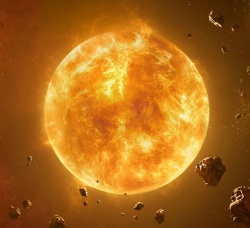
|
| Yhi System
|
|
Outer Rim Territories
|
|
Esstran sector
|
|
E-14
|
|
Yhi
|
- D'urunni
- Aogu
- New Tython
- Suni
- DLSCX-2285
- DLSCX-2384
- DLSCX-2456
- 54 large satellites
- Hoakoa
- DLSCX-2376
- Various planetoids
- Sarakoa
|
|
One
|
|
Suni's belt
|
|
RXV-110
|
|
None
|
|
|
|
|
- Galactic Basic
- Harakoan
- Various languages
|
- ~100,000 Human Colonists
- ~50,000 Mon Calamari Colonists
- ~300,000,000 Natives
|
|
House Odan-Urr
|
The Yhi system is situated in the Esstran sector in the Outer Rim Territories. It is the home system of House Odan-Urr.
Orbits
D'urunni
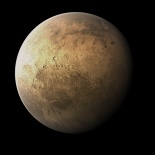
- Distance from the Sun: 14,3 mil. km
- Diameter: 5,420 km
- Revolution period: 40 standard days
- Rotation period: Stationary
- Moons: None
- Atmosphere: D'urunni has a very thin atmosphere, which is produced from melting ice on the night side.
- Temperature: D'urunni's surface temperatures range from 980 degrees to -250 degrees Standard.
- Composition: Rocky planet
A small rocky planet, closest to Yhi's sun. The planet does not rotate around its axis which keeps one side extremely hot and the other extremely cold at all times. It is so close to the sun the temperatures reach a staggering 980 degree standard on the day side and -250 degree standard on the night side. It is, despite its position a very active planet. The proximity to the star means the gravitational pull on the planet is enormous. Volcanoes and geysers constantly erupt on the planet's surface and break away the accumulated ice on the night side.
Aogu
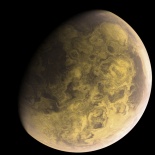
- Distance from the Sun: 112,6 mil. km
- Diameter: 12,687 km
- Revolution period: 250 standard days
- Rotation period: 34 standard hours
- Moons: None
- Atmosphere: Aogu's atmosphere is a thick, acidic fog of toxic gas.
- Temperature: Aogu's surface temperatures range from 420 degrees to -250 degrees Standard.
- Composition: Rocky planet
Aogu is the second planet from Yhi's sun. The greenhouse effect from the proximity to the sun has created one of the most hostile environments in the solar system with winds reaching up to 400 km/h. Covered in a perpetual toxic clouds of ash and sulfur where temperatures soar to 400 degrees and more, the planet is inhospitable to any forms of life. Exploration and exploitation of materials is possible but would be very expensive.
New Tython
Main article: New Tython

- Distance from the Sun: 164,6 mil. km
- Diameter: 9,645 km
- Revolution period: 389 standard days
- Rotation period: 24 standard hours
- Moons: Iah, Kaifu
- Atmosphere: New Tython's atmosphere is composed of oxygen, nitrogen and carbon dioxide, making it breathable.
- Temperature: New Tython's surface temperatures range from 48 degrees to -20 degrees Standard.
- Composition: Terrestrial
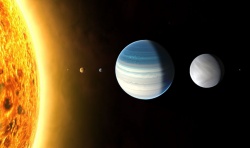 Yhi's sun and planets. Sizes to scale. Distances not to scale.
Yhi's sun and planets. Sizes to scale. Distances not to scale.
New Tython is a Terrestrial planet with a breathable atmosphere, temperate climate and the only one in the system capable of sustaining life. There are four continents on New Tython; ranging from the gigantic continent of Owyhyee in the North West Hemisphere, which has a wide range of different climates (including deserts and grassy plains), to the smallest continent of Sanulu covered in mountain ranges peppered by dozens of semi-active volcanoes, resulting in the region being christened "The Inferno" by the various native populations.
Apart from Owyhyee and Sanulu, there are the two other continents of Kamuekiko and Milil’ea, as well as various islands spread across the oceans of the planet. One such grouping of islands approximately 250 kilometers off the west coast of Sanulu has never been colonized by native or immigrant populations, owing primarily to the fact that they are composed almost entirely of volcanic rock and glass and have no native wildlife upon them.
Suni

- Distance from the Sun: 602,8 mil. km
- Diameter: 273,997 km
- Revolution period: 21,6 standard years
- Rotation period: 10 standard hours
- Moons: DLSCX-2285, DLSCX-2384, DLSCX-2456 and 54 more various large satellites
- Atmosphere: Suni's atmosphere is composed mostly of gases such as hydrogen, methane and helium.
- Temperature: Suni's surface temperatures range from 4 degrees to 12 degrees Standard.
- Composition: Gas giant
Suni is the largest mass in the system apart from Yhi's sun. It is a massive gas giant who's gravity pulls in minor objects and asteroids thus creating a massive asteroid field around the planet. It acts as a natural shield for the inner planets, warding against any larger objects. It is an exploitable resource for those brave enough to test it.
Suni's belt
- Distance from the Sun: 420,6 mil. km to 744,5 mil. km
- Diameter: 332 mil. km
- Composition: Millions of rocky asteroids and satellites
Suni's belt are the leftovers from the creation of Yhi system many billions of years ago. Most objects in the system are drawn into it by Suni's massive gravity. There are 54 planetoids in the belt that circling around Suni.
RXV-110
- Distance from the Sun: 550.1 mil. k to 3.564 mil km
- Diameter: 550.1 km
- Composition: Ice and frozen rock
RXV-110 is a massive comet that travels around the system pulled in and pushed out by Yhi's gravity. As it passes in between Suni and it's asteroid belt, it is pulled by Suni's massive gravity well. It is expected to strike the gas giant somewhere within the next several million years as it keeps drawing nearer and nearer to it.
Hoakoa
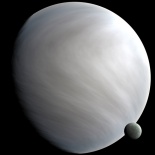
- Distance from the Sun: 1,385,2 mil. k
- Diameter: 124,741 km
- Revolution period: 31,2 standard years
- Rotation period: 18 standard hours
- Moons: DLSCX-2376, Various minor planetoids
- Atmosphere: Hoakoa's atmosphere is similar in structure to Suni, though it has greater concentrations of hydrogen.
- Temperature: Hoakoa's average temperatures is -140 degrees Standard.
- Composition: Gas giant
Much like Suni, this gas giant is a cold, dark and distant world. It's atmosphere is brimming with exploitable resources and it's only moon can be used as a base for future operations. Most of the rest of its moons are either large asteroids or unfinished planetoids.
Sarakoa
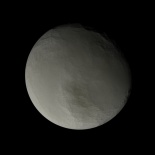
- Distance from the Sun: 2.812,1 mil. k
- Diameter: 2.987,4 km
- Revolution period: 202 standard years
- Rotation period: 9 standard days
- Moons: None
- Atmosphere: Sarakoa has no atmosphere
- Temperature: Sarakoa's surface temperatures -227 degrees Standard.
- Composition: Rocky planet
Furthest from Yhi's sun, Sarakoa is a barren, lifeless planet encrusted in everlasting ice. It is unknown what exactly lies under the ice but it would be beneficial to research any potential resources on the planet. A station could be moved permanently into its orbit to control access to the system.
Map
